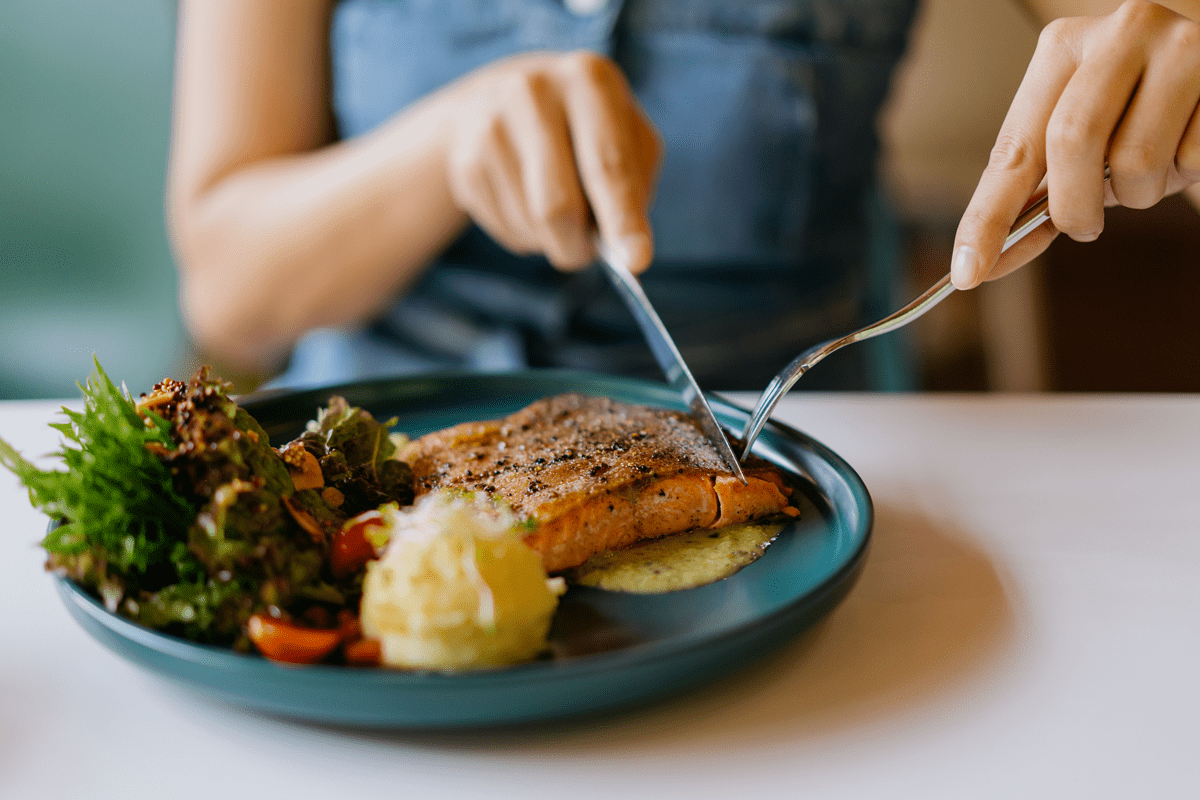Omega-6 and omega-3 fatty acids are two types of polyunsaturated fats that are essential for our bodies to function properly. Since these essential fats can’t be made inside the body, we must consume them through food and/or supplements. In general, omega-6 fats have a pro-inflammatory effect on the body and omega-3’s have an anti-inflammatory effect on the body. Ideally, our diets would include a balance of both types of fats, however the standard American diet is typically very high in the pro-inflammatory omega-6 fats due to high intake of processed vegetable oils. Alternatively, many studies show that increased intake of omega-3 fats are associated with improved health and reduced risk of chronic disease. However over 68% of adults are not meeting the recommended daily intake of omega-3’s. Building up omega-3 fatty acid stores during the preconception period may be helpful for optimizing fertility, improving pregnancy and postpartum outcomes, supporting fetal development, and improving long-term health outcomes by reducing chronic disease risk.
Fertility Benefits:
Consumption of omega-3 rich foods, such as oily fish, is common among Mediterranean style diets which have been shown to be beneficial for fertility. Adherence to an anti-inflammatory Mediterranean style diet has been shown to improve menstrual regularity and there is some evidence that it can also improve Assisted Reproductive Technology (ART) outcomes. Additionally, eating a Mediterranean style diet may also be protective against ovulatory infertility in women with PCOS.
Many studies support the benefits of omega-3 fat intake for male and female fertility, suggesting positive effects on sperm quality, natural conception, and IVF outcomes. One study looking at the effects of omega-3 fat intake in women undergoing IVF treatment showed that higher intake was associated with higher pregnancy and live birth rates. Diets that include omega-3 rich foods are also correlated with more optimal sperm counts and higher sperm quality.
Sources of Omega-3 Fats:
There are three main types of omega-3 fats called ALA, DHA, and EPA. ALA is mainly found in plant sources like flaxseeds and chia seeds, while DHA and EPA are found mainly in fish and seafood. Some ALA can convert to DHA and EPA in the body, however the process is not very efficient. If you don’t eat fish and seafood regularly, it is important to supplement with a fish oil or algae-based omega-3 supplement.
Fish & Seafood: Wild-caught salmon, sardines, rainbow trout, Atlantic mackerel, herring, anchovies, pollock, mussels, and oysters
Nuts & Seeds: Flaxseeds, chia seeds, hemp seeds, walnuts
Animal Products: Meat and dairy products from grass-fed animals, pastured or omega-3 enriched eggs
Sea Vegetables: Seaweeds and algae
Supplement: High quality fish oil or algae-based
Meal Ideas:
Thankfully, there are many delicious ways to eat your omega-3’s daily!
- Season a filet of salmon with salt, pepper, olive oil and a squeeze of lemon. Top with fresh herbs like rosemary or parsley and bake at 400 degrees F until the fish flakes easily with a fork. Option to add halved cherry tomatoes and thick slices of red onion prior to baking, to turn this into a sheet pan dinner that you could serve over quinoa or wild rice!
- Order fresh oysters as an appetizer (avoid raw oysters if you are pregnant or think you might be) or choose the fish entrée in place of the usual steak or chicken.
- Prepare a batch of chia pudding for the week by whisking together 6 tablespoons of chia seeds with 2 cups of your favorite unsweetened plant milk or whole dairy milk. Set aside for a few minutes and then whisk again, to avoid clumps. Store in the fridge in a lidded jar or glass container, for up to a week.
- Add chopped walnuts and freshly ground flaxseed to your morning oatmeal or yogurt parfait. Option to top with seasonal fruit of choice and a drizzle of honey, as needed.
- Incorporate 1-2 tablespoons of chia seeds, hemp seeds or flaxseeds to a smoothie.
- Top your salad with 1-2 tablespoons of hemp seeds and a pastured hard-boiled egg for protein.
- Include nori seaweed sheets as a snack or try a seaweed salad as a side to your main meal.
Overall, eating seafood two to three times per week and including other foods that contain omega-3 fats will help increase overall omega-3 intake. Aim to reduce intake of processed vegetable oils like canola and soybean oil and include additional sources of healthy fats like olive oil, nuts, seeds, and avocados.
SRM offers high-quality, independently tested and research-based nutritional supplements. Many patients are overwhelmed when choosing a quality supplement. We have partnered with reputable supplement companies to create our Fertility and Wellness brand to assist in choosing the right supplements. Check out our entire line of supplements including the Omega-3 and Vegan DHA referenced in the blog post.
References:
- Abodi, M. et al. (2022) “Omega-3 fatty acids dietary intake for oocyte quality in women undergoing assisted Reproductive Techniques: A systematic review,” European Journal of Obstetrics & Gynecology and Reproductive Biology, 275, pp. 97–105. Available at: https://doi.org/10.1016/j.ejogrb.2022.06.019.
- Alesi, S. et al. (2022) “Anti-inflammatory diets in fertility: An evidence review,” Nutrients, 14(19), p. 3914. Available at: https://doi.org/10.3390/nu14193914.
- Jiang, L. et al. (2020) “Omega-3 fatty acids plus vitamin for women with gestational diabetes or prediabetes: A meta-analysis of randomized controlled studies,” The Journal of Maternal-Fetal & Neonatal Medicine, 35(16), pp. 3135–3142. Available at: https://doi.org/10.1080/14767058.2020.1814239.
- Lass, A. and Belluzzi, A. (2019) “Omega-3 polyunsaturated fatty acids and IVF treatment,” Reproductive BioMedicine Online, 38(1), pp. 95–99. Available at: https://doi.org/10.1016/j.rbmo.2018.10.008.
- Murphy, R.A. et al. (2021) “Long-chain omega-3 fatty acid serum concentrations across life stages in the USA: An analysis of NHANES 2011–2012,” BMJ Open, 11(5), pp. 1–8. Available at: https://doi.org/10.1136/bmjopen-2020-043301.




